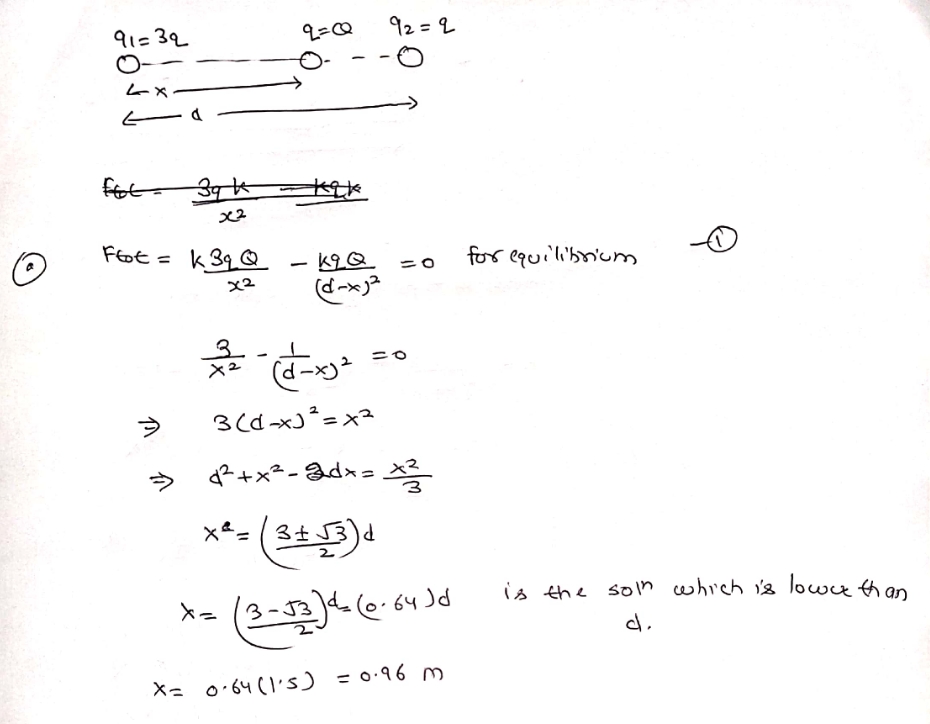Principles of Physics: A Calculus-Based Text
5th Edition
ISBN:9781133104261
Author:Raymond A. Serway, John W. Jewett
Publisher:Raymond A. Serway, John W. Jewett
Chapter19: Electric Forces And Electric Fields
Section: Chapter Questions
Problem 6P
Related questions
Question
Hello there! I understand part A for this problem, but part b has me stuck. For a stable equilibrium I know that for any movement away from x=0 results in a force directed back towards that position. For this problem, the fact that they are both positive charges means that they are repulsive, so the bead will move back towards the equilibrium position when moved. I think this means it is stable, however, how do I prove this mathematically? Thank you!
This is just problem 7, part B to be be clear:-)

Transcribed Image Text:6. Why is the following situation impossible? Two identical dust p
tional and electric forces between the particles happen to have
ticles of mass 1.00 µg are floating in empty space, far from any
each exerts on the other after they have come to equilibrium.
charges that are identical in magnitude and sign. The gravita-
are connected by a conducting wire. Find the electric force
external sources of large gravitational or electric fields, and
at rest with respect to each other. Both particles carry electric
bl
13. BIO Revie
is 2.17 um
par-
ionized: ne
lical molec
becoming
of the mol
Section 19.5
magnitude, so each particle experiences zero net
the same
force and the distance between the particles remains constant.
14. QC S T
The first i
W Two small
7. QC
beads having positive
charges = 3q and
2 = q are fixed at the
opposite ends of a hor-
izontal insulating rod
of length d = 1.50 m.
The bead with charge q is at the origin. As shown in Fig-
ure P19.7, a third small, charged bead is free to slide on the rod.
(a) At what position x is the third bead in equilibrium? (b) Can
the equilibrium be stable?
known ch
92
these cha
of 2k,Q / a
unknown
d
|15. МA unil
charge of
the ring
(d) 100 ci
Figure P19.7 Problems 7 and 8.
16. What are
that will b
ton? (You
8. QCS Two small beads having charges q and of the
same sign are fixed at the opposite ends of a horizontal insu-
lating rod of length d. The bead with charge q, is at the ori-
gin. As shown in Figure P19.7, a third small, charged bead
17. M In Fig
mine the
infinity) :
tric field
18. SA thi
and unit
unit len
the x axi
M Three charged particles
are located at the corners of an
equilateral triangle
Figure P19.9. Calculate
the total electric force on the
7.00-µC charge.
7.00 µC
ure P19.
the elect
as shown
tance y f
0.500 m
its perp
has no x
given by
(b) Using
60.0°
Expert Solution
Step 1

Trending now
This is a popular solution!
Step by step
Solved in 2 steps with 2 images

Knowledge Booster
Learn more about
Need a deep-dive on the concept behind this application? Look no further. Learn more about this topic, physics and related others by exploring similar questions and additional content below.Recommended textbooks for you

Principles of Physics: A Calculus-Based Text
Physics
ISBN:
9781133104261
Author:
Raymond A. Serway, John W. Jewett
Publisher:
Cengage Learning

College Physics
Physics
ISBN:
9781285737027
Author:
Raymond A. Serway, Chris Vuille
Publisher:
Cengage Learning


Principles of Physics: A Calculus-Based Text
Physics
ISBN:
9781133104261
Author:
Raymond A. Serway, John W. Jewett
Publisher:
Cengage Learning

College Physics
Physics
ISBN:
9781285737027
Author:
Raymond A. Serway, Chris Vuille
Publisher:
Cengage Learning


Physics for Scientists and Engineers: Foundations…
Physics
ISBN:
9781133939146
Author:
Katz, Debora M.
Publisher:
Cengage Learning


College Physics
Physics
ISBN:
9781938168000
Author:
Paul Peter Urone, Roger Hinrichs
Publisher:
OpenStax College